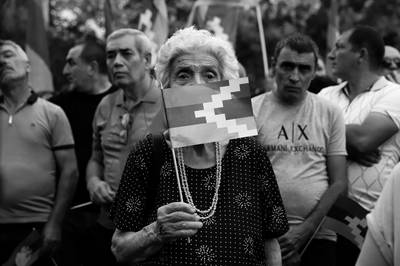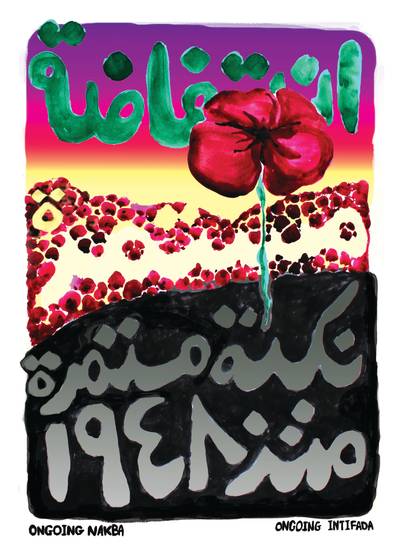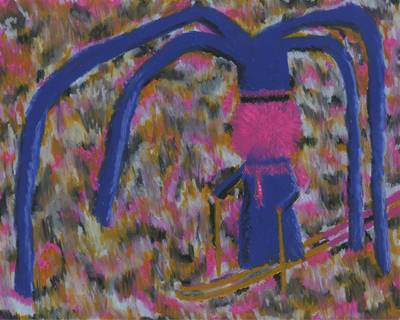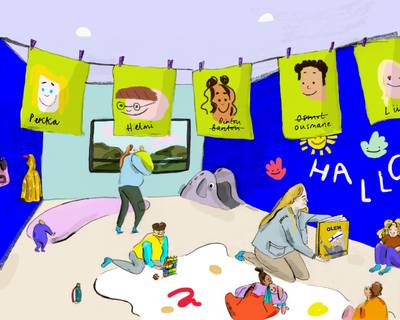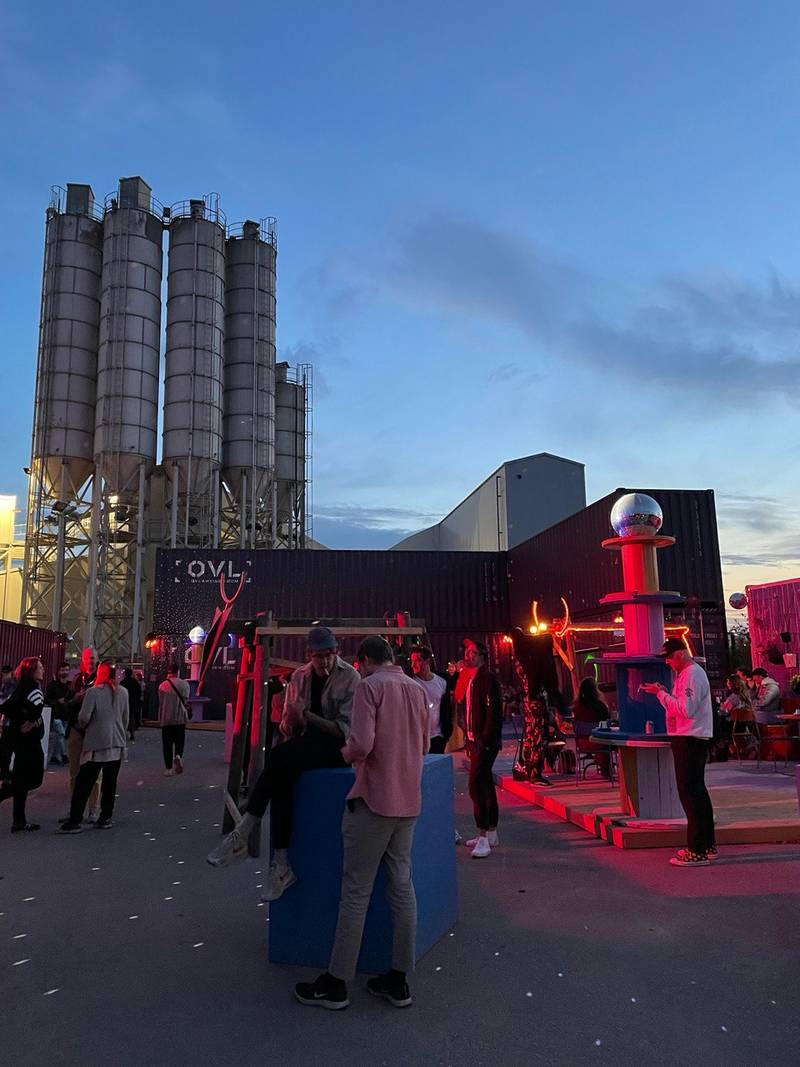

Club Dia. Photo: Marika Pokhodnia
Rohan Stevenson (he/him) is a sociology student and bicycle courier based in London. He has worked in the courier industry for four years, formerly in Edinburgh and Helsinki. Alongside platform capitalism and workers’ rights, his main research interest is eco-fascist online communities. He specialises in qualitative research methods; particularly online ethnography, participant observation, discourse analysis and research with archives. In his own time, he writes fiction and rap, takes photographs and romanticises his melancholic solitude.
Club Dia is a ‘daytime haven born out of a need for a safe and well-thought-out regular open-air venue and hangout in Helsinki’1. Surrounded by a wall of shipping containers and nestled against the Swerock cement factory in Verkkosaari, it comprises a dancefloor, bar, food truck and community radio studio. Decorated with disco balls that sit atop towers of wooden cable reels, its aesthetic speaks of its industrial setting, but the colour scheme and clientele are reminiscent of hip, gentrifying areas such as Kallio.
Club Dia ruffled some feathers when it opened, due to its location at a popular site for open-air, underground parties. In the early summer of 2021, as a heatwave coincided with a drop in coronavirus cases, Verkkosaari became something of an epicentre of Helsinki’s DIY party scene. That July, Kallio-based nightclub Post Bar launched Club Dia on the site, with its founders arguing that there was a need for a safe venue in the area. The day before the opening, Helsingin Sanomat published an interview2 with one of the founders, as well as a Chief Inspector of Helsinki Police, in which safety concerns about the use of the area were discussed in further detail. The article reported how the venue’s opening had also sparked a social media backlash, particularly in response to a DIY skate park being cleared away during the venue’s construction.
In this article, I will unpick this ‘problem’ of safety in Helsinki’s underground music scene - and Club Dia’s subsequent intervention - to explore what the issue of safety ‘can and does do’3 in processes of urban change. In particular, I will look at the ways in which safety issues are represented by the media and the police - using the aforementioned Helsingin Sanomat article as a case study. I will explore how the underground scene is denigrated and devalorised in these representations, before exploring how the creation of abolitionist grassroots safer spaces might make underground parties a site of resistance to this devalorisation.
Safety as a performative emotion
Safety is a slippery term. The dictionary defines it as ‘a state in which or a place where you are safe and not in danger or at risk’4, but there’s a second, more nuanced, definition - safety as a feeling or emotion. An American sudy5 of a ‘gay neighbourhood’ in Washington D.C. found that many respondents defined safety not in terms of protection from crime and violence, but rather as ‘living openly as a gay man’ and ‘being comfortable in my sexuality’. Even though respondents were statistically more at risk from targeted homophobic violence than in other areas of the city, they still felt safer in queer spaces because of a sense of ‘safety in numbers’. The study concluded that this form of safety is an ‘emotional and psychological [one] that comes from being in an area in which one has some sense of belonging or social control, even in the absence of physical control’.
But emotions are not just psychological matters - they ‘create the very effect of the surfaces and boundaries that allow us to distinguish an inside and outside in the first place’6. Emotions are performative in that they are repetitive social and cultural practices and, with that in mind, it’s worth exploring not only what the emotion of safety is, but what it does. Safety is connected to feelings of comfort and ‘freedom of expression’7, and these feelings are often defined against the external threat of an ‘out-group’8 - someone to be safe from. One of the ways in which we make sense of safety is through the metaphors of boundaries and borders which, in turn, play a role in the generation of exclusions. People are therefore ‘othered’ through feelings of comfort and safety and whilst these feelings are triggered by particular readings of bodies and space, they also ‘produce bodies and spaces that are gendered, sexualised, racialised (and classed)’9. In securitised nightclubs, bouncers often preserve ‘good order’10 by removing or denying entry to anyone who is deemed to pose a threat - thereby excluding them from the space.
Much of the literature on nightlife safety is based on ethnographies of queer clubs, where the threat to good order is usually ‘straights’. Club Dia, on the other hand, is not a space associated with a particular identity - queer or otherwise - so it’s less clear who or what constitutes this threat to good order. In the Helsingin Sanomat interview, it is argued that there are many ‘intoxicated minors’ attending underground parties and that ‘people don’t necessarily come there for the music anymore, but to mess around.’11 In the case of Verkkosaari then, it seems that the threat to good order is primarily constituted by the young and unruly.
The interview opens with an image of young people dancing at an underground party, and later on it is argued by the Police Chief Inspector that these ‘intoxicated minors’ are often ‘hostile to the authorities and healthcare staff’12 This serves to construct a media representation that reflects the ‘common positioning of youth by society…as feared, out of control, and in need of regulation’13. Evidence suggests however, that young people are actually significant victims of crime and fear - including property crime, violence and harassment. The ‘production and regulation of young peoples’ space is central to the persistence of this paradox’ with many of the public spaces that young people share with adults increasingly becoming restricted to them14 15. The opening of a club - and the age-restricted entry policy that inevitably entails - only serves to further restrict young peoples’ access to public space.
In the interview, it’s also argued that some people attend underground parties to ‘mess around’ rather than ‘for the music’ and that this is ‘not good for our music culture’16. The response to this problem is the opening of a ‘well-thought-out’17 venue - the implication being that existing underground parties are not so. This distinction can be seen as another boundary in the form of a value judgment differentiating between ‘good’ and ‘bad’ ways of participating in club culture. The ways in which people participate in club culture are shaped by subcultural capital, which is, in turn, shaped by upbringing and education, which confers social status. Subcultural capital is the ‘linchpin of a system of distinction in which cultural hierarchies correspond to social ones’18, and people’s responses to culture are predominantly a marker of class. Subcultural capital is often embodied in the form of ‘being in the know’ and behaving in certain ways in club settings. In the case of Verkkosaari, then, those who attend underground parties to ‘mess around’ are seen to have less subcultural capital than those who are ‘there for the music’.
The existing underground music scene in Verkkosaari is thus devalorised according to the specific discursive processes of Helsinki’s club culture. Interestingly, this discourse mirrors the ‘taste war’ that erupted amongst rock music culture in response to the growing popularity of disco music in the mid-seventies - in which discos were attacked for ‘epitomising the death of music culture’19. In the UK in particular, anti-disco sentiment contained classist convictions about ‘mindless masses’ and intergenerational conflict about the ‘poor taste of the young’20. One article in music magazine Melody Maker described disco culture as ‘a slick moving conveyor belt of the best product from the world’s rock factories, relayed by the finest amplification, with a deejay and lights to inject further doses of adrenalin’21. The anti-underground discourse constructed in the pages of Helsingin Sanomat thus repeats the same criticisms that threatened our club culture predecessors.
Although it can convert into economic capital, subcultural capital is not completely class-bound. Nonetheless, in the case of Verkkosaari, there does appear to be some relationship between the two. Similarly to the classist convictions of ‘mindless masses’ at mid-seventies discos, the invocation of ‘messing around’ seems class-coded. Furthermore, those with the subcultural capital to attend parties ‘for the music’ are also those who can afford the entrance fee, security fee and drinks at city-centre prices of a Helsinki nightclub. The discursive ‘othering’ of the lower classes is less explicit than that of young people, but is present nonetheless. We thus see a discourse that produces bodies and spaces that are predominantly aged and classed.
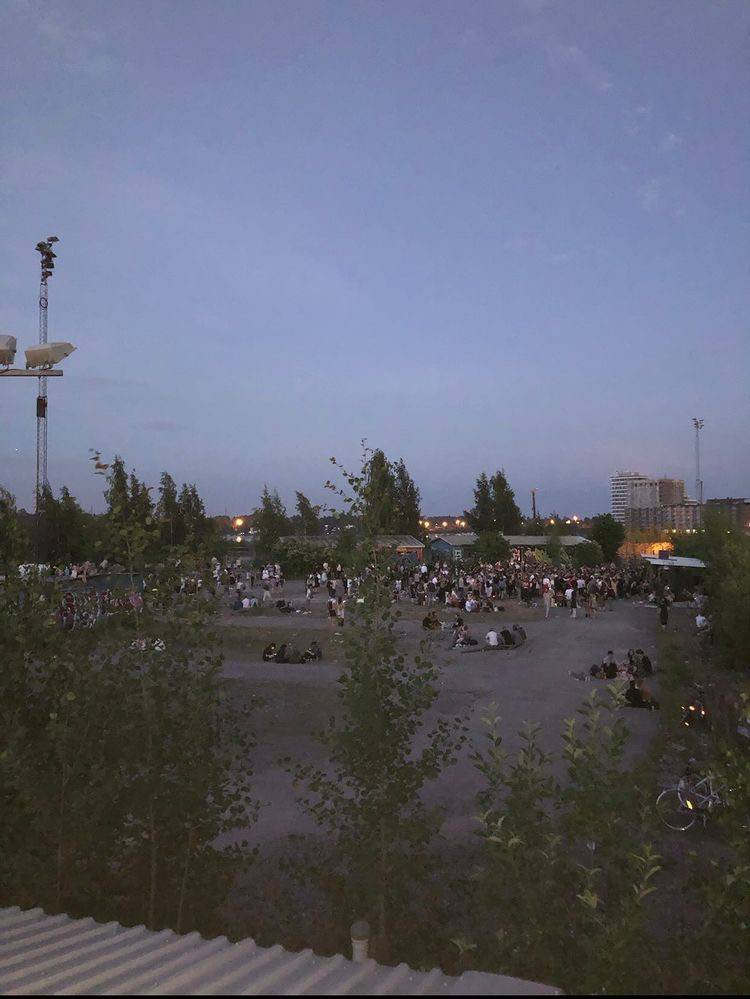

A DIY open-air party in Verkkosaari. Photo: Erika Sirola
The ‘reputational gap’ and ‘frontier’ narratives
The ‘othering’ and devaluation of people is often entangled with the devaluation of the places in which they are believed to congregate - through a process of ‘territorial stigmatisation’22. Territorial stigmatisation is often linked to gentrification23 with the representational devalorisation of space paving the way for its economic revalorisation. When the state and private companies intervene to enact gentrification, strategically stigmatising the existing land uses can work very effectively as a justification for doing so24.
Gentrification is most likely in places where there is a sizeable ‘reputational gap’25 between the current reputation of a site and the reputation it could have were it put to a different land use. It is precisely the areas that suffer from negative media representations - where ‘the contrast with the rest of [the city] could hardly be more stark’26 - that are most at risk of becoming gentrified. The stigmatisation of what does exist is thus central to the legitimacy of what could exist. One way in which this stigmatisation is carried out is through the idea of a ‘frontier’ between ‘savagery and civilisation’27. Frontier discourses attempt to ‘rationalise and legitimate a process of conquest’ and contain symbolic meanings, such as the social difference between ‘us’ and ‘them’. In the frontier programme, the ‘civilising’ urban pioneer is pitted against the essentialised ‘urban outlaw’28.
Returning to the question of what the emotions of comfort and safety ‘do’, we can see that, in the case of Verkkosaari, they serve to representationally devalorise the area and the people believed to be using it and thus justify its economic revalorisation as a site of development. As we have seen, the language of comfort, safety and ‘freedom of expression’ is also a language of boundaries - of a ‘frontier’ that excludes those who pose a ‘threat to good order and its preservation’29. In the Helsingin Sanomat interview, images of uncivilised behaviour are evoked by the image of a ‘24/7 Burning Man with no rules’ while the Police Chief Inspector emphasises the presence of urban outlaws engaging in drug sales, assaults and theft30. Verkkosaari is represented as a ‘wasteland’ where regulation is both desired and required.
Behind all this lurks the City of Helsinki - who leased the land upon which Club Dia is constructed. Whilst these two actors share an imperative of capital accumulation and a desire to expand the cultural and nightlife economy31, it would be unfair to paint them with the same brush. Post Bar/Club Dia is a single commercial operator trying to stay afloat after a pandemic that heavily bruised the nightlife industry. The City of Helsinki, on the other hand, is embarking on a multi-million euro development which will transform the landscape. Verkkosaari is a ‘sub-area’ in the huge development of Kalasatama, which began in 2009 and will continue into the late 2030s32 and plans for Verkkosaari specifically include 40 floating apartments ‘offering an entirely new form of urban seafront living’33. This will presumably be the final nail in the coffin of the local underground scene. The arrival of Club Dia - while relatively inconsequential in and of itself - is an early sign of the imminent gentrification of the area. It is thus indicative of a much broader process of urban change that poses a threat to Verkkosaari as a site of grassroots urban subculture.
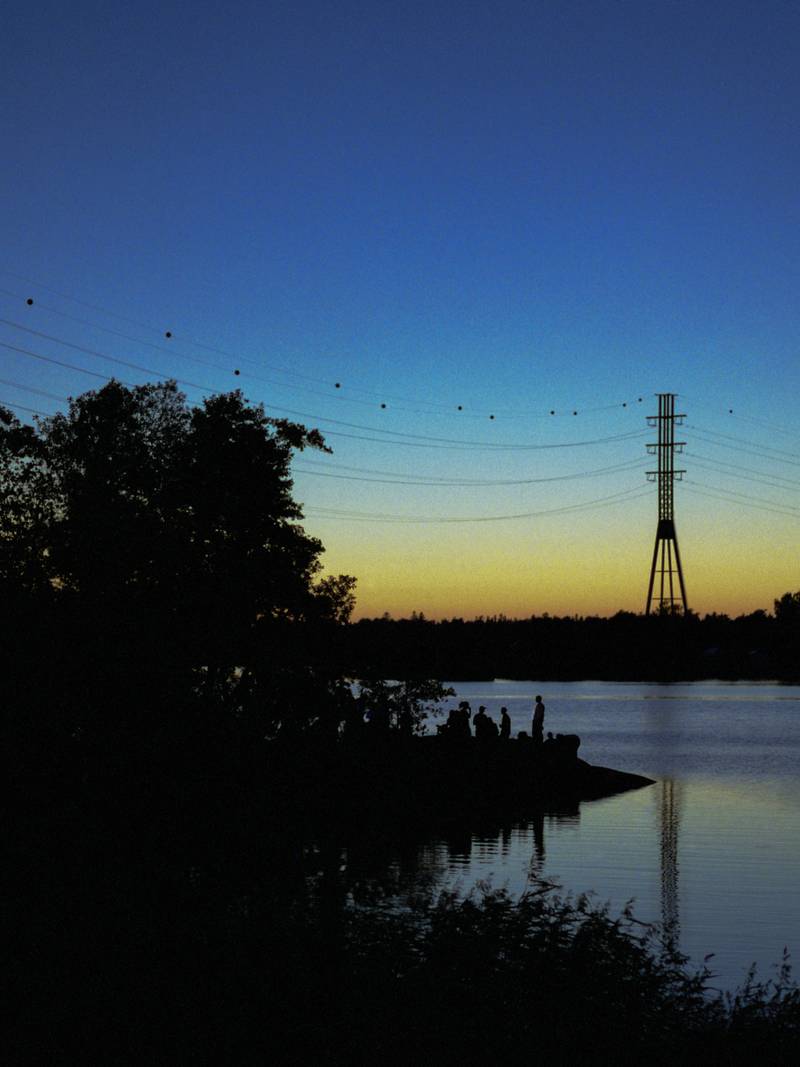

People hanging out in Verkkosaari. Photo: Sam Gladstone South
The ‘values beyond value’ of safer spaces
We live in an era in which ‘urban safety has become a marketable commodity’34. Paradoxically, while there’s plenty of discussion about danger and threat in the Helsingin Sanomat interview, there’s very little discussion as to what a ‘safe’ party might actually look like. This is a ‘hollowed-out’35 vision of safety - the primary function of which seems to be to devalue the site’s existing users. But safety is a malleable term and can also be used in such instances to resist devaluation.
Spaces ‘not completely colonized by capital…’ such as protest movements, food banks and underground parties can often ‘represent the expression of values beyond value’ - the ‘moral, cultural, qualitative and difficult to measure’ values that lie beyond the economic and quantifiable36. For example, a UK study^37 of working-class women engaged in care provision found that whilst they were subject to constant economic and symbolic devaluation by middle-class state representatives, they often pushed back by ‘using a very different value compass’ and stressing alternative values such as selflessness, anti-cruelty and loyalty.
As groups also operate in spaces beyond the logic of capital, there might be potential for those involved in Verkkosaari’s underground scene to resist their devaluation by the City of Helsinki, the national media and the police by stressing an alternative vision of safety centred around ‘values beyond value’. Such visions already exist in other parts of the Helsinki scene: MYÖS, for example - a ‘DIY collective, party platform and co-care network’38 - have created an extensive and publicly-available safer space policy39 (pictured below).
 in the bio of their [Instagram account](https://www.instagram.com/myosclub/?hl=en).](/images/vm3ucYqukk-800.jpeg)
 in the bio of their [Instagram account](https://www.instagram.com/myosclub/?hl=en).](/images/bGtneLJIEY-32.webp)
MYÖS safer safe policy is available via a link in the bio of their Instagram account.
This safer space policy is significantly more substantial than most Helsinki nightclubs and demonstrates ‘a more expansive understanding of personal and community safety’40. It also bears similarities to abolitionist black community safety practices in the USA. ‘Abolitionist’ practices are those ‘that do not extend the legitimacy and power of the police, and that emerge from grassroots collective action in pursuit of community well-being’41. Central to abolitionist community safety is building a ‘culture of care’, which entails ‘creating spaces dense with caring relationships, communal responsibility, acceptance, and community knowledge’42. These four alternate values of a ‘culture of care’ can be found in MYÖS’ safer space policy and could form the basis of an alternative vision of safety for Verkkosaari’s underground parties.
Caring relationships: ‘A safe space [is one] in which ethical relationships which recognise the vulnerability of human life can emerge. A space for asking the other what is needed to make her life more bearable, as opposed to presupposing what the other needs’43. This recognition of the vulnerability of human life is present in MYÖS’ safer space policy by encouraging partygoers to ‘pay attention before discussing topics that might be triggering’ and ‘respect everyone’s physical and emotional boundaries’. Furthermore, partygoers are encouraged to ‘take care of [those who are] not feeling well (maybe due to drugs and/or alcohol…)’ - a marked difference from the exclusion of intoxicated individuals, which is a common policy in commercial clubs.
Communal responsibility: MYÖS fosters communal responsibility by encouraging partygoers to ‘be responsible for your own actions’ and emphasising that it is ‘everyone’s responsibility to take care of each other’. This value is particularly interesting when viewed in the context of the discussions above. As we saw, one of the key safety concerns expressed about Verkkosaari is problem behaviour amongst ‘intoxicated minors’; however, the only intervention made is to create a space that excludes them. A partial cause of problem behaviour amongst young people is the ‘socially constructed powerlessness of adolescents’ whereby they are placed in the frustrating position of being denied any power, control or responsibility over their - and others’ - lives44. The fostering of communal responsibility at underground parties in Verkkosaari could make them into a space in which young people are encouraged to take responsibility for their own actions and for caring for those around them.
Acceptance and community knowledge: MYÖS fosters acceptance through encouraging respect of the opinions, beliefs, experiences, differing opinions, identities and backgrounds of others. Community knowledge is fostered by listening, ‘learn[ing] from past mistakes’ and being aware of ‘your prejudices and privileges and the space you occupy…’. In Verkkosaari, such practices could acknowledge the different ages and varying levels of subcultural capital possessed by partygoers and create an environment in which a range of responses to music and partying are accepted - even ‘messing around’. Furthermore, it would encourage partygoers who take issue with such behaviours to critically reflect on why they do so.
Abolitionist visions of community safety are vital in subcultural spaces because ‘seemingly countercultural havens generally replicate the same structures of race, ethnic, and class inequality and exclusion found in the larger society’45. If these structures are actively dismantled and resisted, then underground parties have the potential to provide ‘a framework for building more equitable social relations’46. The practice of such a vision of safety would help give underground parties in Verkkosaari a social value beyond the logic of capital and form the basis for resistance to the devaluation of Helsinki’s underground scene.
Conclusion
As in any space where large groups of people congregate, safety is an issue in underground parties - and not all of them have safer space policies, let alone ones as comprehensive as MYÖS. Nonetheless, denigrating and devalorising these spaces and the people in them - using a hollowed-out vision of safety - only serves to further exclude and displace groups that are often already marginalised. The meaning of safety and its manifestation in safer spaces has the potential to be a site of struggle. With that in mind, I have suggested that the practice of a grassroots ‘culture of care’ at underground parties in Verkkosaari - and the expression of the ‘values beyond value’ of an alternative vision of safety - could be a fruitful way of pushing back against the devaluation of the area. Inspiration for such a vision can be taken from those already practising grassroots community safety in the Helsinki underground scene, such as the MYÖS collective.
As we have seen, there is an economic incentive for the devaluation of the area - it acts as a potent form of justification for the gentrification rapidly occurring across the city. The Verkkosaari case takes place against a broader backdrop of rampant development and increasing land values in Helsinki - processes which pose a threat to the accessibility of public space and the DIY subcultures that engenders. The idea of safety is ‘like motherhood and apple pie’47, as the expression goes - meaning that it’s difficult to disagree with. But it’s for precisely this reason that it can act as such a powerful justification for processes of displacement and development - and why it’s so important to unpick it.
In the Helsingin Sanomat interview, it is argued by one of Club Dia’s founders that ‘the same DJs and organisers are involved [in both the underground and commercial music scenes]48. This crossover can potentially be a vital asset in protecting Helsinki’s sites of urban subculture - provided we cooperate, collaborate and try to avoid fuelling a media narrative that pits us against each other. It’s in the interests of both the underground and commercial music scenes to resist the development of Verkkosaari. Working together to create inclusive, accessible, community-minded and caring safer spaces might be the first step toward that goal.
